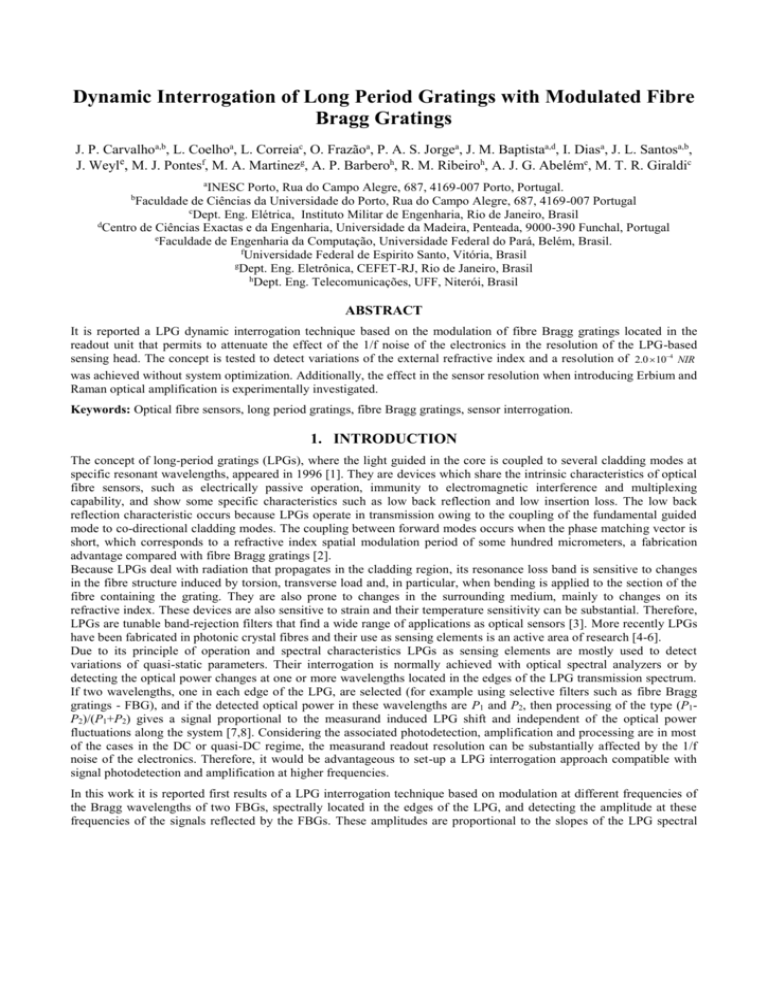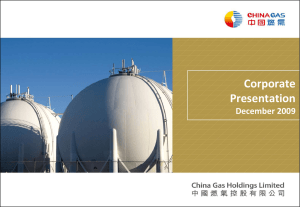Dynamic Interrogatio.. - LEA - Universidade Federal do Pará
advertisement

Dynamic Interrogation of Long Period Gratings with Modulated Fibre Bragg Gratings J. P. Carvalhoa,b, L. Coelhoa, L. Correiac, O. Frazãoa, P. A. S. Jorgea, J. M. Baptistaa,d, I. Diasa, J. L. Santosa,b, J. Weyle, M. J. Pontesf, M. A. Martinezg, A. P. Barberoh, R. M. Ribeiroh, A. J. G. Abeléme, M. T. R. Giraldic a INESC Porto, Rua do Campo Alegre, 687, 4169-007 Porto, Portugal. Faculdade de Ciências da Universidade do Porto, Rua do Campo Alegre, 687, 4169-007 Portugal c Dept. Eng. Elétrica, Instituto Militar de Engenharia, Rio de Janeiro, Brasil d Centro de Ciências Exactas e da Engenharia, Universidade da Madeira, Penteada, 9000-390 Funchal, Portugal e Faculdade de Engenharia da Computação, Universidade Federal do Pará, Belém, Brasil. f Universidade Federal de Espirito Santo, Vitória, Brasil g Dept. Eng. Eletrônica, CEFET-RJ, Rio de Janeiro, Brasil h Dept. Eng. Telecomunicações, UFF, Niterói, Brasil b ABSTRACT It is reported a LPG dynamic interrogation technique based on the modulation of fibre Bragg gratings located in the readout unit that permits to attenuate the effect of the 1/f noise of the electronics in the resolution of the LPG-based sensing head. The concept is tested to detect variations of the external refractive index and a resolution of 2.0 104 NIR was achieved without system optimization. Additionally, the effect in the sensor resolution when introducing Erbium and Raman optical amplification is experimentally investigated. Keywords: Optical fibre sensors, long period gratings, fibre Bragg gratings, sensor interrogation. 1. INTRODUCTION The concept of long-period gratings (LPGs), where the light guided in the core is coupled to several cladding modes at specific resonant wavelengths, appeared in 1996 [1]. They are devices which share the intrinsic characteristics of optical fibre sensors, such as electrically passive operation, immunity to electromagnetic interference and multiplexing capability, and show some specific characteristics such as low back reflection and low insertion loss. The low back reflection characteristic occurs because LPGs operate in transmission owing to the coupling of the fundamental guided mode to co-directional cladding modes. The coupling between forward modes occurs when the phase matching vector is short, which corresponds to a refractive index spatial modulation period of some hundred micrometers, a fabrication advantage compared with fibre Bragg gratings [2]. Because LPGs deal with radiation that propagates in the cladding region, its resonance loss band is sensitive to changes in the fibre structure induced by torsion, transverse load and, in particular, when bending is applied to the section of the fibre containing the grating. They are also prone to changes in the surrounding medium, mainly to changes on its refractive index. These devices are also sensitive to strain and their temperature sensitivity can be substantial. Therefore, LPGs are tunable band-rejection filters that find a wide range of applications as optical sensors [3]. More recently LPGs have been fabricated in photonic crystal fibres and their use as sensing elements is an active area of research [4-6]. Due to its principle of operation and spectral characteristics LPGs as sensing elements are mostly used to detect variations of quasi-static parameters. Their interrogation is normally achieved with optical spectral analyzers or by detecting the optical power changes at one or more wavelengths located in the edges of the LPG transmission spectrum. If two wavelengths, one in each edge of the LPG, are selected (for example using selective filters such as fibre Bragg gratings - FBG), and if the detected optical power in these wavelengths are P1 and P2, then processing of the type (P1P2)/(P1+P2) gives a signal proportional to the measurand induced LPG shift and independent of the optical power fluctuations along the system [7,8]. Considering the associated photodetection, amplification and processing are in most of the cases in the DC or quasi-DC regime, the measurand readout resolution can be substantially affected by the 1/f noise of the electronics. Therefore, it would be advantageous to set-up a LPG interrogation approach compatible with signal photodetection and amplification at higher frequencies. In this work it is reported first results of a LPG interrogation technique based on modulation at different frequencies of the Bragg wavelengths of two FBGs, spectrally located in the edges of the LPG, and detecting the amplitude at these frequencies of the signals reflected by the FBGs. These amplitudes are proportional to the slopes of the LPG spectral response at the FBG wavelengths, which change with the relative spectral movements of the LPG and FBGs, permitting to generate an optical signal proportional to the LPG spectral shift and immune to optical power fluctuations along the system. This technique is tested for measurement of variations of the refractive index of the surrounding medium. Also, the impact of introducing Erbium and Raman optical amplification is experimentally investigated. 2. PRINCIPLE AND EXPERIMENTAL The feasibility of the proposed approach is dependent on the level of slope variation along the LPG spectral resonance. To a good approximation the LPG transfer function can be represented by the following expression [9]: 2 res Pout ( ) Po 1 m exp 4 ln 2 LPG where res and LPG are the LPG resonance wavelength and spectral width, respectively, and m indicates the resonance loss level. For a typical LPG with 20dB of attenuation at res , m=0.99. Figure 1 shows Pout ()/P0 as well as (dPout /d)/P0 versus. It can be observed that the magnitude of the normalized slope variation along the full LPG response is approximately one order of magnitude smaller than the normalized optical power variation, which means a corresponding factor for the signal variations associated with Pout ()/P0 or (dPout /d)/P0 and with origin at a LPG spectral shift relative to fixed wavelength values (that can be defined by FBGs). Therefore, from this argument it seems that the preferable option should be to monitor Pout ()/P0, i.e., following the standard approach. However, this is a DC reading, consequently affected by low-frequency noise, which usually has a 1/f power spectral dependence. On the other hand, the slope approach is compatible with interrogation in a frequency range far from the 1/f noise region, which means the signal-to-noise ratio can eventually be favoured by the Wavelength (nm) reduction of the noise level, eventually compensating with Figure 1 - Pout ()/P0 and (dPout /d)/P0 versus . advantage of the reduction in signal amplitude. 1,0 0,07 (dPout/d PO Pout() / PO 0,8 0,6 0,00 0,4 0,2 -0,07 0,0 1500 1525 1550 1575 1600 Aqueous solution ASE source 1.5 Meters LPG 0 EDF -5 Ampllifier -10 50:50 Optical coupler PZT 1 PZT 2 FBG 1 FBG 2 Transmission (dB) -15 -20 LPG (air) -25 air -30 air -35 water water -40 LPG(water) -45 Photodetector -50 -55 1520 Sum circuit ESA Figure 2 – Experimental setup to test the LPG dynamic interrogation approach. 1530 1540 1550 1560 1570 1580 Wavelength (nm) Figure 3 – Optical spectra of the FBGs and LPG in air and water. To evaluate the feasibility of the proposed interrogation approach the setup presented in Figure 2 was implemented. A LPG with a strong resonance centered at 1550 nm (Figure 3) was fabricated using the electric arc technique (period of the refractive index modulation: Λ = 395 μm; coupling to a 5th order cladding mode). The LPG was placed into a recipient with an aqueous solution of ethylene glycol and illuminated by means of an ASE broadband source. The optical fibre at the LPG right side was mirrored with silver nitrate allowing the sensing head to operate in reflection. Two fibre Bragg gratings (FBG1, FBG2), designed to be spectrally located in each edge of the LPG (1, 2; Figure 3), had their Bragg wavelengths sinewave modulated with a fixed amplitude using two piezoelectric transducers driven by two independent signal generators (f1, f2). After photodetection of the optical signals reflected by the FBGs, the resultant electrical signals were added with an electrical circuit and visualized in an electrical spectrum analyzer (ESA) with adequate impedance matching. The modulation of the FBG resonance originates a relative spectral movement with reference to the LPG transfer function, with a consequent optical power modulation at the modulation frequencies. The amplitude of this power modulation for each FBG would be constant if the LPG response were linear, which is not the case. Therefore, this amplitude is function of the LPG spectral position, which changes due to the measurand variation. This effect can be observed in Figure 4-a for the LPG in air and in water, where it can be seen that the wavelength shift of the LPG resonance at 1550 nm is transformed into an amplitude variation of the two peaks observed in the ESA, each one corresponding to the frequency in which each FBG is being modulated. Due to the selection of the FBG Bragg wavelengths, the corresponding amplitudes change in phase opposition, a useful feature for readout sensitivity enhancement. -40 -40 n=1.3685 n=1.3375 -50 Amplitude (dBvrms) Amplitude (dBvrms) -50 -60 -70 -80 -90 -100 400 -60 -70 -80 -90 500 600 700 800 900 -100 1000 0 Frequency (Hz) 1 2 3 4 5 6 7 8 9 10 11 12 13 Frequency (Hz) (a) (b) Figure 4 – a) Electrical spectra when modulating FBG1 and FBG2 with f1=620Hz and f2=740Hz, respectively, for the LPG located in air and in water; b) Noise level of the electronics at low frequencies. The FBG1 was modulated at f1=620Hz and FBG2 at f2=740Hz, both in a frequency region where the system noise level stabilized at ~ - 90 dBVrms (Figure 4-b). The processing adopted was Vproc= (V1- V2)/ (V1+V2), where V1and V2 are the rms voltage amplitudes of the signals at frequencies f1 and f2, respectively. 3. RESULTS The setup depicted in Figure 2 was used to estimate Vproc in several situations: with and without optical amplification considering local or remote sensing. The obtained responses with the dynamic interrogation approach are shown in Figure 5 when the refractive index of the environment changes (the EDFA amplification is performed as shown in Fig 1). It can be seen the proposed interrogation scheme permits to read refractive index variations, exhibiting Vproc versus n as a linear relationship. Also in all cases the slopes are not substantially different, which is understandable in face of the way Vproc is defined. On the other hand the amplification has real impact in the readout resolution when the sensing head is located far away. b) a) To further test this point, 50 Km of fibre were used located between the sensing head Refractive index Refractive index and the processing region, simulating Figure 5 – System output versus refractive index for the case of not using therefore the situation of a remote sensor. In and using EDFA amplification. Fibre length to the sensing head : a) 1.5 m; this case the Erbium amplification was b) 5 Km. replaced by a Raman amplifier stage operating in the 50 km downlead fibre. The resolution was estimated by applying a refractive index step change of 0.022 RIU and determining the corres-ponding signal change and rms noise fluctuations (the same procedure was done for all cases shown in Table 1). Figure 6 shows the obtained response and from it comes out a resolution of 7.410-4, which is a factor of ~ 6 better compared with the situation of no amplification. Table 1 summarizes the resolutions obtained with the proposed interrogation technique in all situations considered. 0.4 0.8 1.5 m without amplification 1.5 m with Erbium Amplifier 5 Km without amplification 5 Km with Erbium Amplifier 0.6 0.2 0.4 0.2 Vproc (a.u.) Vproc (a.u.) 0.0 -0.2 -0.4 0.0 -0.2 -0.4 -0.6 -0.6 -0.8 1.34 Slope 1.35 1.5 m without amplification -25.3042 1.5 m with Erbium Amplifier -30.2484 1.36 -0.8 1.37 1.38 -1.0 1.34 Slope 5 Km without amplification -25.9272 5 Km with Erbium Amplifier -30.0958 1.35 1.36 1.37 1.38 1.39 Length of the Fibre to the Sensing Head -0.30 n = 1.357 n= n = 1.379 -0.35 Value Vproc (a.u.) -0.40 Standard Error n = 1.379 -0.34851 0.00268 n = 1.357 -0.60637 0.00245 1.5 m -0.45 5 Km -0.50 -0.55 50 Km -0.60 -0.65 0 4 8 12 16 Configuration nmin Without amplification 2.5E-04 Erbium amplification 2.4E-04 Without amplification 4.3E-04 Erbium amplification 2.2E-04 Without amplification 4.5E-03 Raman amplification 7.4E-04 20 Time (s) Figure 6 – System output for a refractive index step variation (sensing head located 50 km away; system with Raman amplification). Table 1 – Refractive index resolutions obtained with the dynamic interrogation technique for the several studied configurations. These results permit to state the following: first, the technique proposed based on signal reading outside the 1/f noise level is effective for refractive index measurement with a resolution that compares favorably with the obtained using the standard DC approach (which is typically around 1 10 3 [8]), and this in the situation where the localization of the FBGs relative to the LPG spectral response was far from being optimised. Second, amplification associated with the processing employed provides a combination that permits to keep interesting resolutions even when the sensing head is remotely located. These two characteristics route to the critical aspect of operating far from the low-frequency noise. Indeed, from Figure 4-b comes out that the noise level present in these experiments was ~ 25 dB lower than the one shown at 1 Hz, which far compensates the lower signal variations associated with the proposed slope readout technique. Further work is going on to explore the potential of this interrogation technique, which can be applied not only to LPGs but also for other structures used for measurement of DC or quasi-DC measurands (such as SPR devices). 4. CONCLUSION In this work a dynamic LPG interrogation technique was presented. It was based on the analysis of the electrical spectrum of two modulated fibre Bragg gratings located in the LPG edges. This concept permits to attenuate the effect of the 1/f noise of the electronics when determining the refractive index measurement resolution. 5. ACKNOWLEDGEMENTS This work was supported by project AMBISENSE (CNPq 61/2008; FCT 411.00). REFERENCES [1] A. M. Vengsarkar, P. J. Lemaire, J. B. Judkins, V. Bhatia, T. Erdogan, J. E. Sipe, “Long-period fiber gratings as band-rejection filters”, Journal of Lightwave Technology, 14, 58-64, 1996. [2] J. M. López-Higuera (Editor), “Handbook of Optical Fibre Sensing Technology”, John Wiley (2002). [3] S. W. James, R. P. Tatam, ”Optical fibre long-period grating sensors: characteristics and application”, Measurement Science and Technology, 14, 49-56, 2003. [4] H. Dobb, K. Kalli, D. J. Webb, “Temperature-insensitive long-period grating sensors in photonic crystal fiber”, Electronics Letters, 40, 657-658, 2004. [5] J. S. Petrovic, H. Dobb, V. K. Mezentsev, K. Kalli, D. J. Webb, I. Bennion, “Sensitivity of LPGs in PCFs fabricated by an electric arc to temperature, strain and external refractive index”, Journal of Lightwave Technology, 25, 1306-1312, 2007. [6] L. Rindorf, O. Bang, “Highly sensitive refractometer with a photonic crystal-fiber long-period grating”, Optics Letters, 33, 563564, 2008. [7] H.J. Patrick, G.M. Williams, A.D. Kersey, J.R. Pedrazzani, A.M. Vengsarkar, “Hybrid fiber Bragg grating/long period fiber grating sensor for strain/temperature discrimination”, IEEE Photonics Technology Letters, 8, 1223-1225, 1996. [8] R. Falate, O. Frazão, G. Rego, J. L. Fabris, J. L. Santos, “Refractometric sensor based on a phase-shifted long-period fiber grating”, Applied Optics, 45, 5066-5072, 2006. [9] L.A. Ferreira, E.V. Diatzikis, J. L. Santos, F. Farahi, “Frequency Modulated Multimode Laser Diode for Fibre Bragg Grating Sensors”, Journal of Lightwave Tecnology, 16, 1620-1630, 1998.





